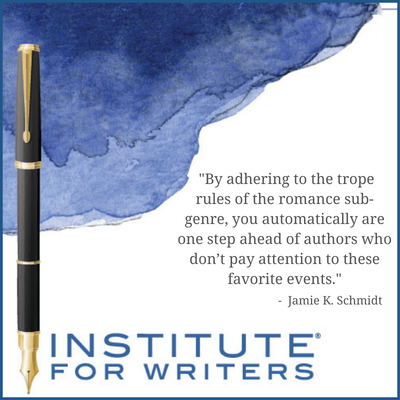1000 N. West Street #1200, Wilmington, DE 19801
© 2024 Direct Learning Systems, Inc. All rights reserved.

It’s a fine line between trope and trite. They are both common themes or ideas that have been in countless stories. A popular romance trope is enemies to lovers or opposites attract. As the name implies, the protagonists start out on opposites sides of a cause or are adversaries. This could be a couple from two rival gangs, families, or cultures. Or it could be business rivals or two people competing against each other in a sport. This trope is also called “Two dogs, one bone.”

Insta-love is an example of a trope that’s gone trite. Insta-love is when the two protagonists meet and immediately fall in love. While “love at first sight” is a good start of a novel, there has to be more tension between the couple. Otherwise, it’s a boring book. They met. They fell in love. They got married. The end. No one wants to read that—unless there’s conflict in between. Readers want the romance characters to suffer and earn their happily ever after (HEA) or happy for now (HFN).
Romance readers have expectations for the trope depending on the sub-genre. Writing a successful novel hinges on following the tropes. For example, paranormal romance readers expect the following tropes in their werewolf romances:
1. There is an alpha wolf, usually the male.
2. The alpha male instantly recognizes his life mate and pursues him or her with relentless determination.
3. Wolves mate for life so this is his one and only. The mating bond is permanent—which is usually a cause for tension and strife.
Messing with these three tropes for werewolf romance can be a disaster for your novel.
Readers of this genre expect these unwritten rules to be followed. You can play around with them, but too much deviation will leave the reader dissatisfied and unlikely to pick up any more books of yours. In a worst case scenario, they could also leave bad reviews on reader sites and convince others not to try your book.
In commercial Amish romances the following tropes apply:
1. It is a faith-based romance. No swearing, sex. or drug use should be detailed in the book.
2. The romance is between a man and a woman.
3. One or both characters are Amish. At the end of the book, both characters will be fully embraced in the Amish society.
(Check out our recent podcast episode with Wanda Brunstetter, a popular Amish novelist, for tips on writing Amish romance.)
As of this writing, a gay Amish romance would not find a traditional publisher. Neither would one with explicit sex. Those books would have to be self-published, but even then you wouldn’t be attracting the Amish reader.
Trite things to watch out for in Amish romances are barn raising and buggy accidents. The reason they are trite is because they seem to happen in every novel. You don’t want your readers to check off an imaginary bingo card of things they’ve seen before.

In a fantasy romance, the world building is just as important as the romance development. In a science fiction romance, the science needs to be well researched and believable.
No matter what sub-genre you’re writing, avoid the following trite clichés:
• The TSTL heroine – TSTL means Too Stupid To Live. She’s the one that goes down the stairs in the haunted house in her underwear.
• The Mary Sue heroine – The Mary Sue is the heroine that everyone loves. She’s perfect. No one hates her. Everyone lives just to propel her character arc forward. Often in fan fiction these characters are also called “author insertions,” meaning that the author writes themselves into the story.
• The perpetual damsel in distress – The heroine who always needs someone—usually the hero—to save her.
• Abusive relationships. I’m all for a good “redeem the villain” story. But in a romance novel, the villain /anti-hero you’re redeeming can NEVER be abusive to the heroine. There are some sub-genres like dubcon (dubious consent) and darkfic (dark fiction) where this is the trope, but in contemporary romance fiction this is generally not supported.
By adhering to the trope rules of the romance sub-genre, you automatically are one step ahead of authors who don’t pay attention to these favorite events. Absolute deal breakers in romance are infidelity or one of the protagonists dying at the end. Your story needs to have an emotionally satisfying journey and a happy ending. Not having those two things doesn’t make it a bad book, but you won’t be able to successfully market it as a romance novel. The popularity in genre fiction reflects society as a whole. There is a great need for escapist fiction right now, and romance is the perfect way to get away from it all and get lost in a story that is guaranteed to have a happy ending.
Did you know we have instructors who specialize in writing romance? Let us help you get your love story off the ground with a one-on-one mentor. Take the assessment and be matched with one today!
USA Today bestselling author, Jamie K. Schmidt, writes erotic contemporary love stories and paranormal romances. Her steamy, romantic comedy, Life’s a Beach, reached #65 on USA Today, #2 on Barnes & Noble and #9 on Amazon and iBooks. Her Club Inferno series from Random House’s Loveswept line has hit both the Amazon and Barnes & Noble top one hundred lists. The first book in the series, Heat, put her on the USA Today bestseller list for the first time, and is a #1 Amazon bestseller. Her book Stud was a 2018 Romance Writers of America Rita® Finalist in Erotica. Her dragon paranormal romance series has been called “fun and quirky” and “endearing.” Partnered with New York Times bestselling author and actress, Jenna Jameson, Jamie’s hardcover debut, SPICE, continues Jenna’s FATE trilogy.
1000 N. West Street #1200, Wilmington, DE 19801
© 2024 Direct Learning Systems, Inc. All rights reserved.
1000 N. West Street #1200, Wilmington, DE 19801
© 2024 Direct Learning Systems, Inc. All rights reserved.
1000 N. West Street #1200, Wilmington, DE 19801
© 2024 Direct Learning Systems, Inc. All rights reserved.
1000 N. West Street #1200, Wilmington, DE 19801
© 2025 Direct Learning Systems, Inc. All rights reserved.
1000 N. West Street #1200, Wilmington, DE 19801
©2025 Direct Learning Systems, Inc. All rights reserved. Privacy Policy.
7 Comments